It's part of our very fabric: Why Dorset buttons are 'sew' big for a Birstall crafter
and live on Freeview channel 276
But now Gini Armitage’s skills are helping to weave a bright as a button future for the ancient craft – and a booming online business – as her handmade collection of traditional fasteners and adornments catches on.
She has taught her 13-year-old daughter, Elli, how to make Dorset buttons, and is also delivering workshops at craft shows she attends throughout the year at Alexandra Palace, London, and the NEC in Birmingham.
Advertisement
Hide AdAdvertisement
Hide AdDorset Buttons have a fascinating history as Gini, who runs a craft shop in Birstall, explained.
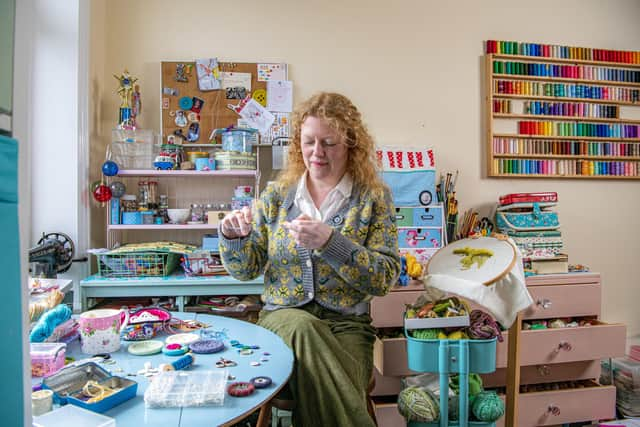

“It was invented in Dorset by a wealthy landowner and is based on a farm’s cartwheel. He decided to use a sliced sheep horn to make the ring, and sheep’s wool to do the thread.
"He used all the resources on the farm and used all the farm workers who were not working on the land to make them. They would be made for clothing, originally for undergarments, because they were plain, but they started to dye them,” she said.
Experimentation with cotton threads and more intricate designs and different colours to match materials led to Dorset Buttons becoming more fanciful and demand grew.
Advertisement
Hide AdAdvertisement
Hide AdSoon the once plain cream buttons, which had been hidden on undergarments, were adorning the garments of Gentry and Royalty.
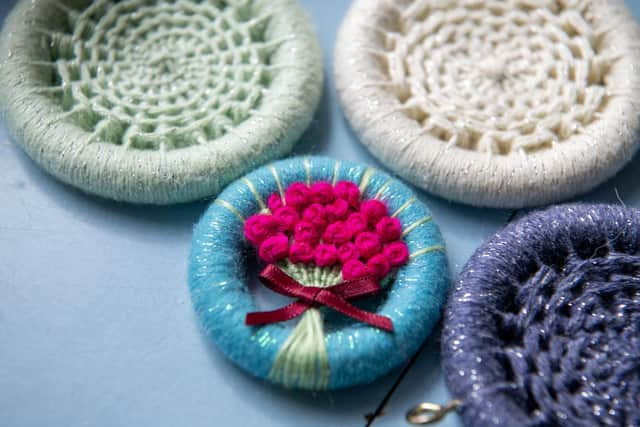

Buttoners were recognised for their skill and, at one time, had their own Guild.
“Buttoners became so good at it they could make up to 70 a day,” said Gini, who can make one in 15 minutes.
“I have been making them so long – 33 years – I can make one without looking at it.”
.Gini is used to stepping back in time.
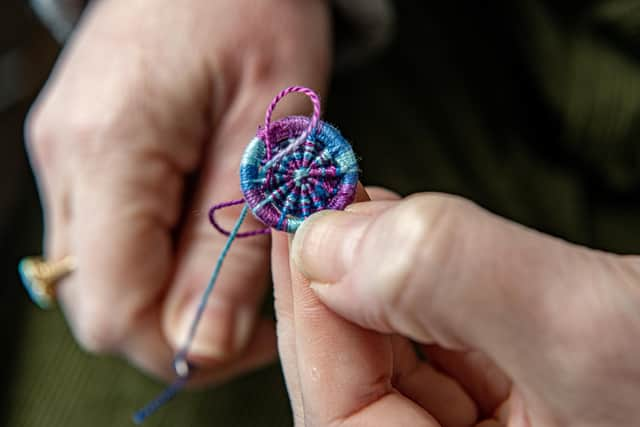

Advertisement
Hide AdAdvertisement
Hide AdAttending re-enactment events throughout the UK with her father, Gary, not only gave her an insight into lives previously lived, it enabled her to play the part.
“We would go around the country doing Vikings and Medieval events. We just loved dressing up, we have always been in costume, but we did it in a very historical way. We were really into the history.
“I would make the clothes because my Grandma taught me how to sew. I would do the weaving and things like that.
“We were all very crafty. My father was an artist and he did all the accessories, the clogs, leather belts and the metalwork and we would learn together,” said Gini, whose brother has also inherited the creative gene as an artist and lecturer at various London universities.
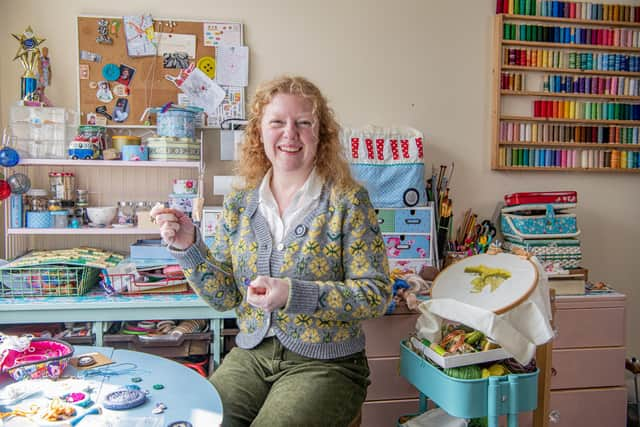

Advertisement
Hide AdAdvertisement
Hide AdSeeing the practice of traditional skills at the events they attended inspired Gini, who, at that time, was studying archaeology at college.
“When we went to the re-enactments we would see people who would be making things, weaving on looms.
“My professor at college knew we were into this and he gave me a book about small accessories. It had a picture of Dorset Buttons and the history but I had no idea how to make them.”
Captivated by the craft, Gini and her father had attended re-enactment events in Dorset and, through contacts, were put in touch with a ‘Buttoner.’
Advertisement
Hide AdAdvertisement
Hide Ad“They said they were made by ‘Buttoners’ and they knew a ‘Buttoner’ who still existed – they would get in touch with her to see if she would speak to me about it.”
Miriam, the Buttoner that Gini would eventually meet, wrote to her young prodigy and, because she knew Gini was interested in history through her enthusiasm for the re-enactment world, she agreed to pass on the skill.
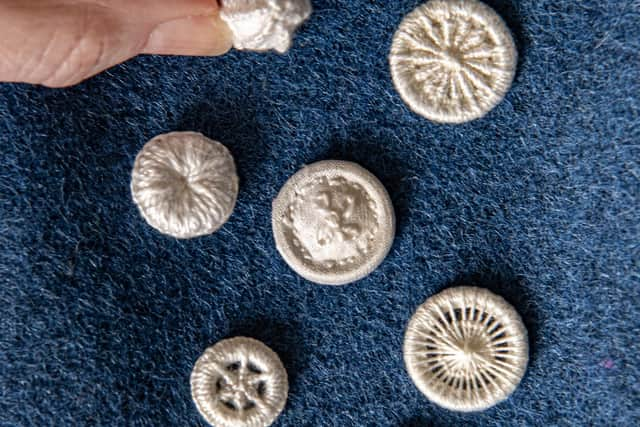

“When my father took me to see her she was this little old lady in her 80s. She said to my father ‘leave her with me’ – I was 18 at the time, and I was very shy, but I spent the whole day with her.
"She told me she had no siblings and no children to pass it down to. It is a tradition passed from mother to daughter is this skill as a buttoner, and she was concerned it would die out and it had been passed down 100 years through her family.
Advertisement
Hide AdAdvertisement
Hide Ad“But she didn’t want to give it to someone who would do it as a basic craft and not take it seriously, and because we were very interested in the history of it she asked me to be her next of kin and she taught me all the skills, all the styles, the history and everything and I promised I would be the next in line in her family of buttoners.”
Sadly, Miriam has since passed away but, true to her word, Gini, a former librarian in education and the NHS, is handing down the skills through her own family.
She is also raising the profile of this important tradition as part of the online business she set up after becoming a mum.
“Miriam would be absolutely over the moon knowing I have a daughter who will be passing it on,” said Gini, who is thought to be one of only seven professional Dorset Button makers in the UK.
Advertisement
Hide AdAdvertisement
Hide AdThe introduction of machinery brought about the demise of Dorset Buttons in the late 1800s.
Their resurgence ties in with the growing interest and popularity of traditional crafting techniques.
Hangings, stitch markers and jewellery, including necklaces, brooches, and beautiful earrings - featuring the original cartwheel to the more complex daisy, honeycomb and tree designs - are among the collection of Dorset Button adornments created with a blunt embroidery needle and pearl cotton stitched around a brass ring and displayed around ‘Gini’s Boutique’ – the craft emporium Gini opened in Birstall last September.
Wall to wall shelves are a showcase for the local crafting community she supports, among them the bespoke crafts created by a special needs adult day service.
Advertisement
Hide AdAdvertisement
Hide AdThere is something of interest on every level leading to the upstairs habadashery.
Glass cabinets display a range of traditional skills with handmade items that have been crocheted, knitted and stitched.
The shop is an extension of the business that began online – and boomed during lockdown, in part, to Gini’s participation in Kirstie Allsopp’s ‘Keep Crafting and Carry On’ in 2020.
Gini said she had met the TV presenter at a few crafting events and when she heard about the lockdown programme she applied and was delighted to take part, demonstrating how to create Dorset Buttons from materials at home.
Advertisement
Hide AdAdvertisement
Hide AdFollowing on from her appearance, she also took part in Kirstie’s Handmade Christmas in the same year and was delighted when the judges chose her Dorset button design – which took four hours to create from scratch - as the winner.
“I cried. I couldn’t believe it was me.”
In the aftermath of her fame, Gini was flooded with orders through her website.
Opening a gift shop, initially in Dewsbury before moving to Birstall, offered her a retail presence in a high street setting for customers to call in and see the crafts up close.
“I was overwhelmed with orders, it was crazy,” said Gini, whose popular seller is the Dorset Button kits she creates to pass on the skill.
Advertisement
Hide AdAdvertisement
Hide Ad“I think Miriam would love it – I have taught thousands of people how to do it.”
Gini has passed on the skill to people all over the world, including Japan, and has worked with the blind, teaching by touch, and the deaf.
“It is a very mindful course,” she said.
“I am really proud that I can pass it on. It is such a rare craft and it should not die out.
“Traditional crafts like this need to be kept alive, and it is nice to put it out there and see people grasp it. It gives me such joy to make them, and to be able to see other people happy doing them as well. It is a relaxing craft. I never tire of it and I will remember every single button I have made.”
For more information visit https://ginisdorsetbuttons.com